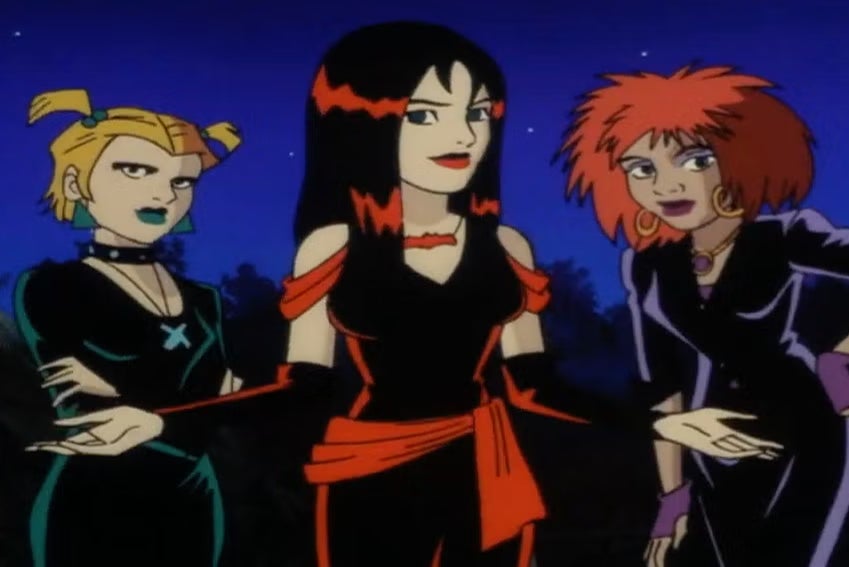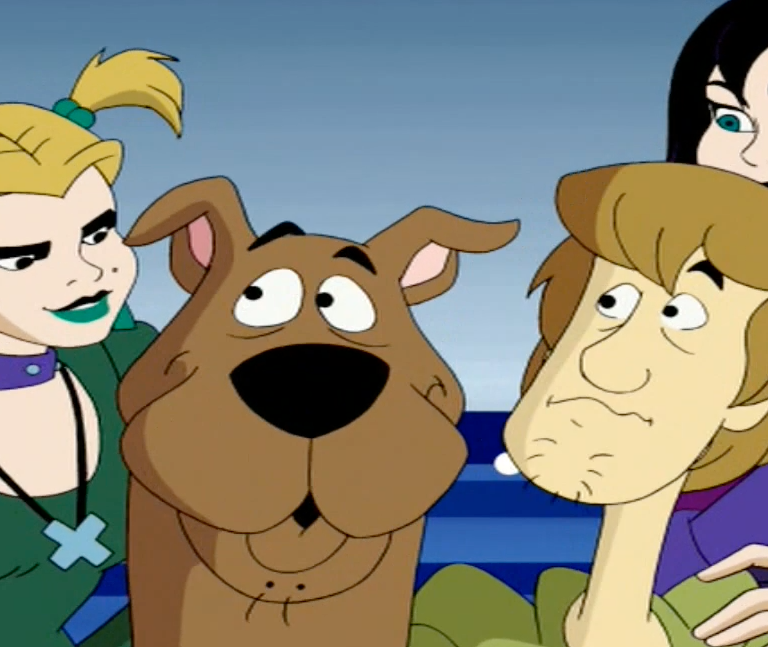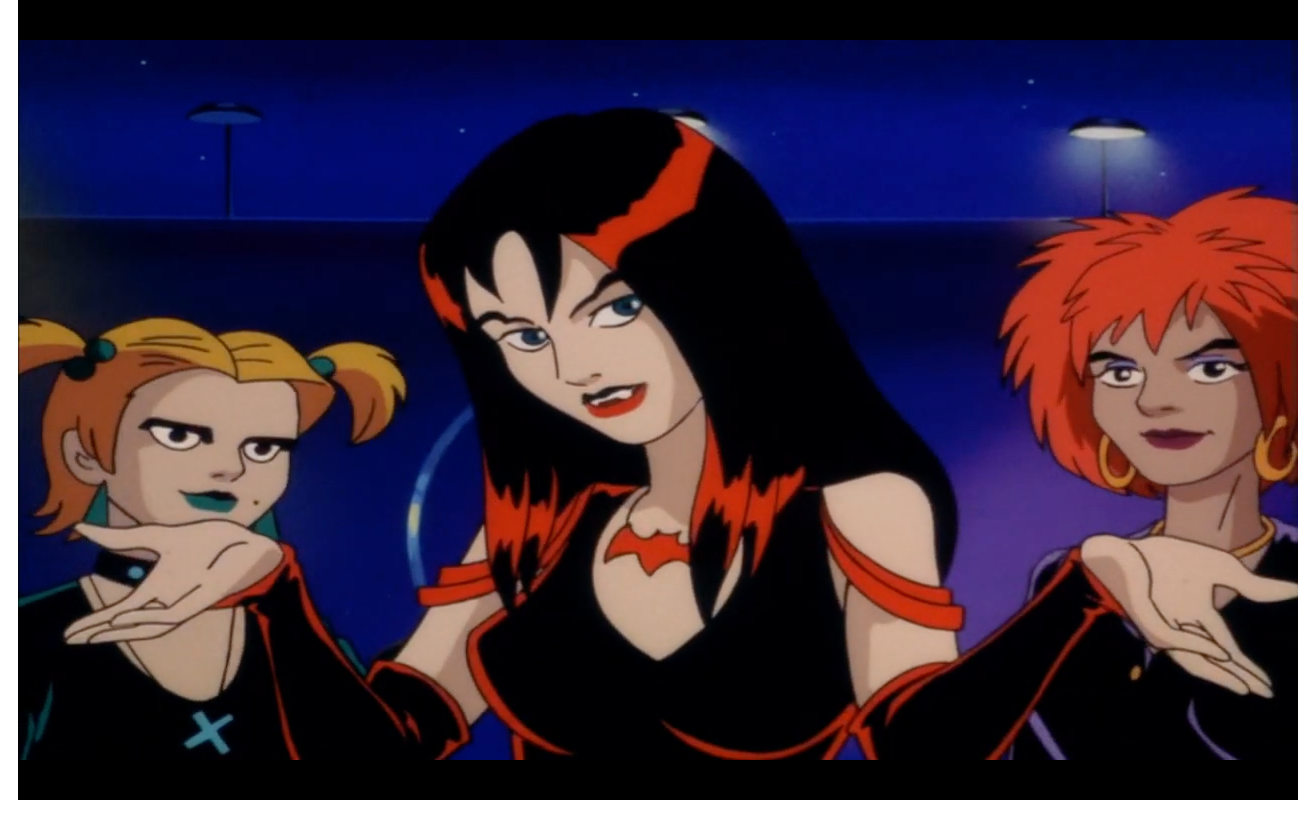The Hex Girls: How a fictional Scooby-Doo rock band became cult, queer, girl-power icons
Twenty years after the pop-punk ‘eco-goths’ first enraptured a generation, speaks to the creator and voices behind animation’s coolest, edgiest and most environmentally friendly fake band


Your support helps us to tell the story
From reproductive rights to climate change to Big Tech, The Independent is on the ground when the story is developing. Whether it's investigating the financials of Elon Musk's pro-Trump PAC or producing our latest documentary, 'The A Word', which shines a light on the American women fighting for reproductive rights, we know how important it is to parse out the facts from the messaging.
At such a critical moment in US history, we need reporters on the ground. Your donation allows us to keep sending journalists to speak to both sides of the story.
The Independent is trusted by Americans across the entire political spectrum. And unlike many other quality news outlets, we choose not to lock Americans out of our reporting and analysis with paywalls. We believe quality journalism should be available to everyone, paid for by those who can afford it.
Your support makes all the difference.In 1999, a fictional pop-rock band in a straight-to-VHS Scooby-Doo movie made every queer, goth and/or weirdo child feel seen. Debuting in Scooby-Doo and the Witch’s Ghost, a more straight-faced and late-Nineties take on the classic Scooby characters, The Hex Girls were only ever intended to be mysterious, guitar-shredding red herrings in a single movie – suspects in the rumoured sighting of a ghoul haunting a New England museum. But there was something about their rebellious, outspoken and vaguely homoerotic energy tenhat struck a chord.
Voiced by Jennifer Hale, Kimberly Brooks and singer/songwriter Jane Wiedlin, who came to fame in the pioneering new wave rock band The Go-Go’s, the Hex Girls were comprised of Wiccan musicians Thorn, Dusk and Luna – self-described “eco-goths” determined to protect the environment, who sported stick-in vampire teeth and possessed a direct line to the spirit world.
Born amid a wave of Wiccan representation in mainstream television, most notably Buffy the Vampire Slayer and Charmed, they were somewhat radical for entertainment strictly aimed at children. In fact, they were stroppy, defiant and infinitely cooler than Shaggy, Fred and Co, who could do little but stare in awe at the colourful trio bashing out catchy pop-punk tracks such as “Earth, Wind, Fire and Air” and “Who Do Voodoo”.
In the two decades since, they have occasionally re-appeared in Scooby projects and become cult icons – a camp and empowering testament to prepubescent pop culture for a generation currently struggling through their mid to late twenties. But it’s been the queer community that has most embraced them. A number of viral tweets this year have only jokingly blamed the Hex Girls for awakening them to their sexualities, highlighting a largely unappreciated element of late-Nineties queer culture in the process.
“I believe the Hex Girls were beneficial both as introductions to queerness as well as witchcraft,” says Moriah Benton, an illustrator and production coordinator and creator of the Queer Babes of Cartoons zine. “They provided many people, but predominantly young femmes, with the first notion that there was an alternative to societal defaults, both in gender presentation and spirituality. I think that’s why they’ve become such treasured queer figures despite not being specifically expressed as such. They represent so much of what the queer community is about: personal power, found family, the defying of traditional expectations of femininity, and being unabashedly freaky.”
“I’m dumbfounded at the staying power of the girls!” Hex Girls creator Rick Copp tells The Independent. “We call certain characters ‘breakouts’, and if they speak to a certain part of the culture, they’re gonna be a breakout. I think it’s self-evident that’s really happened here. They were dangerous and fun, and for a Scooby-Doo movie they were edgy.”
“I occasionally go to conventions to promote other shows,” says Brooks. “But I always get a number of fans who come up and go, ‘I love the Hex Girls so much!’ or ‘I grew up with them! I wish there was more Hex Girls!’”
Adds Wiedlin: “They’re so sassy! I love that about them. A lot of female characters still tend to be milquetoast-y and just like – blah, bland and whatever. But these girls kick ass. Can you imagine being a little girl and seeing a cute, young woman bashing out on the drums? I think that could change someone’s life. That is a very big statement, but I really think it’s true.”
To celebrate the 20th anniversary of Scooby-Doo and the Witch’s Ghost, and because the Hex Girls are today Halloween costume staples, The Independent gathered together Hale, Brooks, Wiedlin and Copp to run through the origins of the coolest fake band in animation, discuss the trio’s legacy today, and express why a Hex Girls spin-off series is long overdue.

Watch Apple TV+ free for 7 days
New subscribers only. £8.99/mo. after free trial. Plan auto-renews until cancelled

Watch Apple TV+ free for 7 days
New subscribers only. £8.99/mo. after free trial. Plan auto-renews until cancelled
In 1998, writers Rick Copp and David A Goodman were approached by Warner Bros to write a Scooby-Doo animated movie to be released on home video. They wanted something slightly spookier than the Scoobys of the past, with genuine supernatural elements, less overt silliness and a more polished and grown-up look courtesy of Japanese animators with roots in anime. During the writing process, Copp had just one key request: he wanted the film to feature a “spooky girl band”.
Copp: Growing up, I was a huge fan of Josie and the Pussycats. I was a little gay kid and I think it was that girl power that appealed to me. But I was also fascinated by this group of girls travelling the world and getting involved in criminal conspiracies. So naturally I was like, “We have to have a girl band!” I remember coming up with the name Hex Girls and I kept thinking: “Is it too simple? Is it not clever enough?”
Casting began in earnest in early 1999, with producers searching for voiceover actors who could project strength and spunk, and hold a note. Famed voiceover actor Jennifer Hale, best known at the time for voicing Felicia Hardy on the classic Nineties Spider-Man series, was recruited to play lead vocalist Thorn. Relative newcomer Kimberly Brooks, who has gone on to an illustrious voiceover career in film, television and video games, was cast as keyboardist Luna. And Jane Wiedlin, of The Go-Go’s and a solo music career that included pop classics “Rush Hour” and “Blue Kiss”, was cast as drummer Dusk.
Wiedlin: I think I have a pretty unique voice but, to be honest, the people that really get work can do 10 or 20 voices at the drop of a hat. It’s a real talent. Me? I just kind of do variations of my normal voice. So I was surprised that I got asked to do this! But of course really honoured. I think someone over at Scooby-Doo thought, “Oh, how cool would it be to have a real girl from a real girl band be in this fake girl band?” So I kind of lucked out in that regard.
Brooks: I had worked with Jennifer on some other things so I was familiar with her. I had never worked with Jane, but I was a huge Go-Go’s fan so I was completely blown away. I was in awe. I still am when I’m around her.
Hale: I actually have never told Jane this, but I was in garage bands and started singing in clubs when I was 15 and we covered The Go-Go’s! So when I got this gig and Jane was one of the Hex Girls, I was just like, “What??!!” It was a wonderful confluence of events, a kind of circular experience.

Brooks: I grew up doing musical theatre, and I always wanted to be in a rock band. In fact, when I was in high school, it was career day and we had a psychic there. The psychic called me up in front of the entire senior class and did a reading on me. She didn’t know anything about me, but she told me, “You know what, you’re gonna have an amazing career using your voice.” So, of course, I was like, “Oh my god, I’m gonna be a rock star!” That didn’t really pan out. But I did get to play one on TV.
Wiedlin: Over the years, it’s kind of like a family reunion every time we see each other. They are wonderful women, and so talented. I’m a little bit in awe of them and what they can do and how easily it comes to them. I just try to breathe and relax. I feel like I’m this amateur walking in because I haven’t done a ton of voiceover, but they’re so nice.
During recording, all three actors quickly got a handle on their characters. But there was just one problem: nobody could figure out what an “eco-goth” actually was.
Copp: As one of the writers on the movie, I’m as baffled as you! I can’t imagine I’m smart enough to come up with that, so I don’t think it was me!
Wiedlin: I remember bursting out laughing when I first saw that description! They’re not really that goth. I mean, their music isn’t a bit goth, let’s face it. They have a goth aesthetic, though.
Hale: We actually had to debate how to pronounce it. We were like, “Echo-goth?” “Ee-ko-goth?”
Brooks: It definitely is sort of made-up sounding, but I also knew what it meant, in a weird way. I just thought: a bit of that tree-hugger thing? We love the earth, we’re vegan and we don’t wear leather. I think it was kind of a stereotype of that at the time? But now? Look at our planet, look at the state of what we’re in, look at global warming, look at how we’re polluting our planet, and we’re finally having to really take notice because we’re running out of time. So for me, now it totally makes sense – the “eco-goth.”

Copp and Goodman’s original script didn’t go into detail about the Hex Girls “sound”, beyond describing their music as “goth pop”. They didn’t write the lyrics either. Those were taken care of by co-writer Glenn Leopold, who also did a full polish of their script, with music produced by Bodie Chandler. The band’s vocals, however, were supplied by the actors themselves.
Brooks: That is us singing! And doing all the harmonies. Jane was so instrumental in developing those, and Jennifer’s amazing, too. They both have such great ears for the music. At some point we kind of sound like The Go-Go’s because of the way that Jane arranged those harmonies!
Hale: I’ll be honest, I don’t remember every lyric from every one of them, but they’re catchy songs, right? And the fans really enjoy them. I’m asked fairly regularly to bust out a small piece of a Hex Girls song when I go to conventions.
Wiedlin: As a life-long songwriter and musician, I always sort of thought, “Oh, they’re gonna come to me for tips and they’re gonna run these songs by me and see what I think.” But it hasn’t been like that at all, because I was hired as an actor, and not a musician and a songwriter. Everyone sort of stays in their lane, including me. Every single time I’ve gone into the studio to record my voice, I always say, “Don’t forget, I’m a songwriter if you ever need any Hex Girls songs!” So far it hasn’t worked. Except for one time [on “Who Do Voodoo”, a track heard in 2003 film Scooby-Doo and the Legend of the Vampire]. But at least I got to do it once. You never know, maybe in the future it will happen again. It was really fun to write a song for a cartoon.
Upon its release in October 1999, Scooby-Doo and the Witch’s Ghost proved slightly controversial due to its content – the film saw Scooby and the gang reading from spell books, while the Hex Girls were proudly Wiccan and believed in the religion being a force for good rather than evil.
Copp: The only blowback we got was from conservative parents because we were “promoting Wicca”. It was all “Scooby-Doo is a devil worshipper!” and stuff like that. It was crazy. But the movie was very popular so [that controversy] was silenced by the DVD sales, I believe.
The film was so popular, in fact, that Warner Bros briefly debated spinning the Hex Girls off into their own series.
Copp: They had found that there was a lot of chatter about the Hex Girls from the movie, and I remember my friend Linda Steiner [then the Vice President of Development at Warner Bros Television Animation] brought me in for a meeting to talk about a spin-off series. You can imagine my excitement! Oh my god, doing a girl band series! And they wanted David and I to develop it. We talked about it, but it just never... it was one of those Hollywood meetings that never really went anywhere.
Wiedlin: I absolutely think they could have their own show! Every time they could introduce a new song and they could be the defenders of the planet plus do rock concerts. It’s such an easy sell! If it happened I would be so excited. I live in Mexico, but I would totally fly back every time to LA to do the episodes. Totally, I don’t care.
Hale: I’d be there with bells on! I’d be beating down the door. I’d be 30 minutes early with coffee for everyone.
Brooks: There’s still time, right? I don’t know who to talk to – I need to call my agent, somebody needs to get the ball rolling here!
Copp: You never know, though, given their resurgence and their place in the history of queer icons, which is now a term I’m gonna say every day. In fact, somebody just contacted me from Cartoon Network not too long ago. Maybe I’ll pitch it to them again?
Brooks: I didn’t really recognise it at the time, but having my own daughter and now in hindsight with, I don’t know, just the state of the world right now and #MeToo and women striving so much for equality and representation – it’s even more of a bolster for the argument that we should be trying to revive these characters. We need strong characters that have their own point of view and their own perspectives, who speak their minds and aren’t stereotypical girls. I love that we’re different and that we represent all types of women, which is just so important right now. I think that definitely played a role in why people identify with them.

There’s also the Hex Girls and their queer fanbase, which continue to celebrate them to this day.
Copp: In terms of the Hex Girls being queer icons, I take such pride in that! But it was completely accidental. I co-wrote The Brady Bunch Movie, and I very deliberately created a lesbian character in that because I wanted to make an impact and I wanted to push the gay agenda, so to speak! Then years later I did a series called Where the Bears Are, which is about gay bears. But with the Hex Girls, that’s a complete accident.
Wiedlin: I think any time anyone from the LGBT+ community as young people can have someone to look up to, they’re gonna look up to them – so it doesn’t surprise me. I didn’t actually know that [about the Hex Girls], but it doesn’t surprise me a bit. Of course The Go-Go’s have a huge queer fanbase, both with men and women, and I love it. They’re my people, they’re my tribe.
While the Hex Girls spin-off hasn’t (yet) materialised, the band have reappeared here and there throughout the years – in series including What’s New Scooby-Doo and Scooby-Doo: Mystery Incorporated.
Hale: When I look back on my career, Thorn definitely holds a very special place in my heart. The fact that they’re a group of strong women having a blast doing something they love, and then there’s the obvious, giant, all-caps “YES PLEASE” that I get to sing and do awesome stuff. It’s a dream role.
Brooks: I feel like those Hex Girls are the coolest characters I’ve ever played. They’ve got the songs, they’ve got the look, the girl band thing is amazing. I do a lot of voices, but they’re just special.
Wiedlin: For a long time I had no idea that anyone had even noticed the Hex Girls, because it’s not like we’re in every episode. But I think it was during the last recording that Jen and Kimberly told me that they get a lot of fanmail about them and on YouTube there’s clips of the Hex Girls, so I was very surprised to hear that. But it’s kind of neat, too, to stand out. Because Scooby-Doo – those characters are all so iconic. I don’t think it’s easy to stand out at all as an occasional character. So that makes me really happy. And it’s nice to have a cult following for anything!
Join our commenting forum
Join thought-provoking conversations, follow other Independent readers and see their replies
Comments